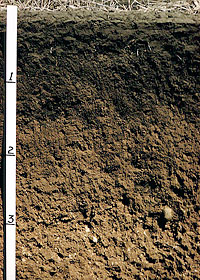- Home
- Learn about salinity
- Get to know your site
- Design a landscape
- Solve a problem
- Other information
Salinity Management Guide
Assessing the physical characteristics of soil
Evaluating the thickness and layering of soil

To help detect a subsurface layer of impervious soil, dig a hole about two feet deep when the soil is not overly dry or wet. Place a measuring stick vertically inside the hole, fill the hole with water to within a few inches from the top, and allow the water to drain for several hours. An impervious lower layer may exist if the level subsides less than half an inch per hour.
It may also prove useful to study the layers of soil — known as horizons — in profile. From within a hole dug several feet deep, examine the soil's horizons. If necessary, scrape off a few inches of soil from the profile with a trowel to expose a fresh face. Starting from the top and working toward the bottom, observe the soil's characteristics. Feel the profile carefully for distinguishing characteristics, such as texture, to help define the horizons.

Place a marker, such as a nail, at the top and bottom of each horizon you've identified. After placing a tape measure or yard stick on the profile so that zero inches is at the surface, measure the depths at which each horizon begins and ends.
Describe the soil profile in your notebook and photograph it. Before taking the photo, make sure the sun is at your back, so that horizons and depths can be clearly seen. Also photograph the landscape around the profile. While examining the profile, make particular note of the uppermost horizon in which roots don't grow. Take a sample from that horizon and submit the sample to a laboratory for analysis. If the laboratory tests reveal that the layer contains substantial amounts of low-permeability material, such as clay, or cementing agents, such as calcium carbonate or magnesium carbonate, then the horizon is very likely an impervious one.
| « Previous page | Next page » |